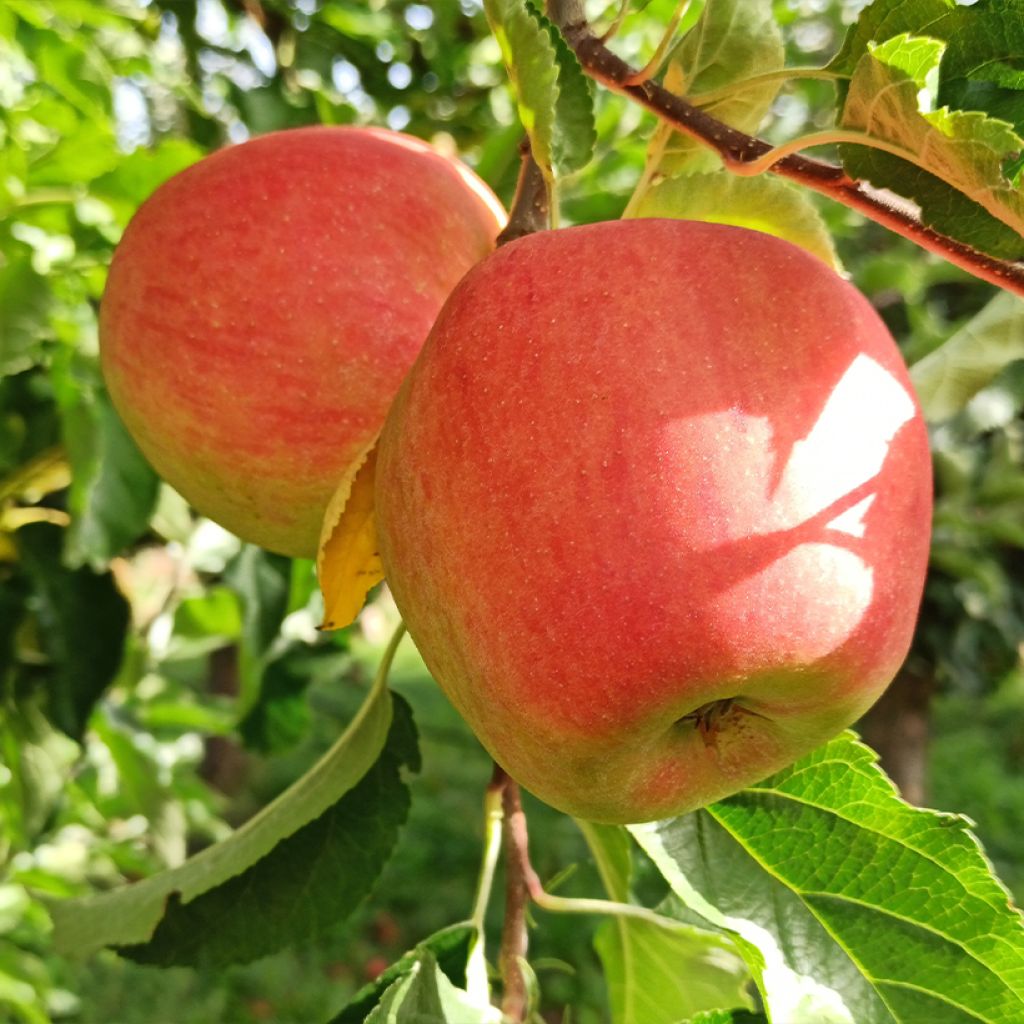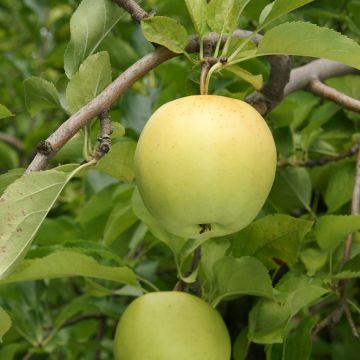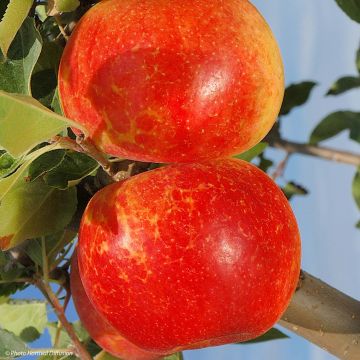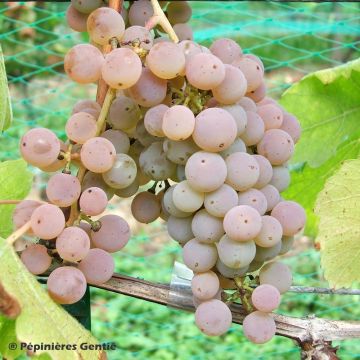

Pommier Belle fille de l'Indre


Pommier Belle fille de l'Indre
Organic Apple Tree Belle fille de l'Indre - Malus domestica
Malus domestica Belle fille de l'Indre
Apple, Orchard apple, Table apple, Cultivated apple
The cutting was topped, what a shame! Otherwise, beautiful recovery.
Irène, 25/08/2024
Special offer!
Receive a €20 voucher for any order over €90 (excluding delivery costs, credit notes, and plastic-free options)!
1- Add your favorite plants to your cart.
2- Once you have reached €90, confirm your order (you can even choose the delivery date!).
3- As soon as your order is shipped, you will receive an email containing your voucher code, valid for 3 months (90 days).
Your voucher is unique and can only be used once, for any order with a minimum value of €20, excluding delivery costs.
Can be combined with other current offers, non-divisible and non-refundable.
Home or relay delivery (depending on size and destination)
Schedule delivery date,
and select date in basket
This plant carries a 6 months recovery warranty
More information
We guarantee the quality of our plants for a full growing cycle, and will replace at our expense any plant that fails to recover under normal climatic and planting conditions.
Description
Malus domestica Belle fille de l'Indre is an old variety, known for producing apples that can be stored for a long time and have excellent taste for various culinary uses. It produces medium to large, round apples, flattened at the base, and slightly conical towards the top, the size will vary depending on the number of fruits on the tree. The smooth, thin, and shiny yellow-green skin, is washed and streaked with red when exposed to sunlight. The white flesh is firm, fine, crisp, juicy, very sweet, and delicately flavoured. Harvesting begins in October, and the fruits can be consumed from late November and can be stored until April-May if the harvest is late and the storage conditions are optimal. It is a self-sterile variety that requires the presence of other apple varieties for pollination.
Malus domestica, also known as Malus communis or Malus pumila, is commonly called the Common or Domestic Apple tree. It belongs to the Rosaceae family. Present in France and Europe since ancient times, it is native to the forests of Central Asia. It is very hardy and is probably the most cultivated fruit tree in Northern Europe. There are approximately 20,000 varieties, including around 10,000 of American origin, 2,000 of English origin, and 2,000 of Chinese origin. The Belle fille Apple, also known as Belle femme or Belle Bourguignonne, has very ancient and poorly known origins that may date back before 1600. There are many variations of 'Belle Fille': from Burgundy, Indre, Creuse, Salins, Manche, Normandy, and Berry. The Belle fille de l'Indre can be found in Indre, Creuse, and Haute-Vienne.
The Belle fille de l'Indre apple tree has a spreading habit and can reach approximately 5m (16ft) high and 4m (13ft) wide when fully grown. Its habit is well suited for low or high forms and espaliers. Its leaves are large, ovate, dark green on the upper sid, whitish-green on the underside, and deeply toothed. The late blossom appears around early May, which generally protects it from frost. The flowers are destroyed by frost at temperatures below -2 to -3°C (28.4 to 26.6°F). It is a variety adapted to cultivation in regions with not too late frosts. The Apple tree is a hardy plant that can tolerate temperatures around -20°C (-4°F), making it suitable for cultivation in all regions. Its abundant white blossom is remarkably decorative in spring and highly attractive to bees for nectar and pollen. Despite its vigour, it produces poor-quality pollen, making it weakly capable of pollinating other apple varieties. It produces apples with few or no fertile seeds. It is said to be self-sterile, which is why the presence of apple trees that bloom at the same time is necessary. Varieties such as Court Pendu, Jacques Lebel, Jonathan, Reine des Reinettes, Reinette du Mans, Reinette Etoilée, Reinette du Canada blanc, Winston, or any other late-flowering variety are suitable for cross-pollination.
The Belle fille de l'Indre apple tree is a vigorous, highly fertile variety, quick to bear fruit, extremely productive and fairly resistant to canker, powdery mildew, and scab.
A crisp, juicy, and sweet apple that can be eaten raw or cooked, in compotes, pastries, paired with cheese, or as an accompaniment to savoury dishes such as black pudding, pork, or salads. It is also perfect for making juice. The apple is easy to eat and satisfying. It is rich in carbohydrates and fructose, invigorating, energising, and rehydrating. Its content of vitamins A, B, C, and E, minerals, antioxidants, and fibre makes it a healthy choice. The fruits can be stored throughout winter, even until April if the harvest is late. Store in a cool, clean place, protected from light, at a temperature of around 8 to 10°C (46.4 to 50°F), or in a cold room, sealed from outside air, at a temperature of 1 to 3°C (33.8 to 37.4°F). Apples release ethylene, a gas that promotes fruit ripening. To accelerate the ripening of other fruits or vegetables, place your apples next to them.
The apple tree is popular in gardens because of its fruits. Among the wide range of apple trees, it is easy to find a variety that suits.
Report an error about the product description
Organic Apple Tree Belle fille de l'Indre - Malus domestica in pictures


Plant habit
Fruit
Flowering
Foliage
Botanical data
Malus
domestica
Belle fille de l'Indre
Rosaceae
Apple, Orchard apple, Table apple, Cultivated apple
Cultivar or hybrid
Other Apple trees
View all →Planting and care
Choose a sunny spot for your Belle fille de l'Indre Apple tree , the soil can be slightly chalky or acidic, but not excessively so. Dig a wide planting hole at least 3 times the volume of the root ball. Add organic matter (potting soil, compost...) and a base fertiliser such as crushed horn. Do not bury the graft union. Stake if necessary. For apple trees planted in isolation and exposed to the wind, it may be a good idea to stake them by installing a bracing system: plant 3 stakes in a triangle 50 cm (20in) around the trunk, and connect them with pieces of wood. Protect the bark with a piece of rubber, for example, and attach the stakes to the trunk with wire. Water abundantly, even in winter, even if it rains. Fruit trees are best planted between October and March, outside the freezing period. Container-grown plants can be planted all year round, except during periods of high heat or frost.
In winter you can add a small handful of wood ash at the base of the tree, lightly incorporated into the surface of the soil, it is rich in potassium, which will improve fruiting. The Apple tree can be subject to various diseases and pests. To reduce risks, space the trees sufficiently and install multi-species hedges, nest boxes or insect hotels to attract beneficial insects. In summary: prioritise diversity. The main diseases of the Apple tree are scab (brown spots on the leaves), brown rot (wilting of the flowers and rotting of the fruits on the tree), and powdery mildew (white powdery coating on the leaves). For these three cases, preventive action is best by spraying a decoction of horsetail, as a last resort and in case of severe attacks, you can apply a treatment based on Bordeaux mixture. As for pests, the codling moth (or fruit worm) is a small caterpillar which makes tunnels inside the fruit. To remedy this, it is best to act preventively by encouraging birds and bats, by placing nest boxes. In case of aphid infestation, spray a solution based on black soap.
During the harvest in September, only keep the picked fruits. For good storage, place the apple with its stem downwards, on racks or in crates. Choose a completely dark, dry and cool, frost-free place.
Planting period
Intended location
Care
-
, onOrder confirmed
Reply from on Promesse de fleurs
Similar products
Haven't found what you were looking for?
Hardiness is the lowest winter temperature a plant can endure without suffering serious damage or even dying. However, hardiness is affected by location (a sheltered area, such as a patio), protection (winter cover) and soil type (hardiness is improved by well-drained soil).

Photo Sharing Terms & Conditions
In order to encourage gardeners to interact and share their experiences, Promesse de fleurs offers various media enabling content to be uploaded onto its Site - in particular via the ‘Photo sharing’ module.
The User agrees to refrain from:
- Posting any content that is illegal, prejudicial, insulting, racist, inciteful to hatred, revisionist, contrary to public decency, that infringes on privacy or on the privacy rights of third parties, in particular the publicity rights of persons and goods, intellectual property rights, or the right to privacy.
- Submitting content on behalf of a third party;
- Impersonate the identity of a third party and/or publish any personal information about a third party;
In general, the User undertakes to refrain from any unethical behaviour.
All Content (in particular text, comments, files, images, photos, videos, creative works, etc.), which may be subject to property or intellectual property rights, image or other private rights, shall remain the property of the User, subject to the limited rights granted by the terms of the licence granted by Promesse de fleurs as stated below. Users are at liberty to publish or not to publish such Content on the Site, notably via the ‘Photo Sharing’ facility, and accept that this Content shall be made public and freely accessible, notably on the Internet.
Users further acknowledge, undertake to have ,and guarantee that they hold all necessary rights and permissions to publish such material on the Site, in particular with regard to the legislation in force pertaining to any privacy, property, intellectual property, image, or contractual rights, or rights of any other nature. By publishing such Content on the Site, Users acknowledge accepting full liability as publishers of the Content within the meaning of the law, and grant Promesse de fleurs, free of charge, an inclusive, worldwide licence for the said Content for the entire duration of its publication, including all reproduction, representation, up/downloading, displaying, performing, transmission, and storage rights.
Users also grant permission for their name to be linked to the Content and accept that this link may not always be made available.
By engaging in posting material, Users consent to their Content becoming automatically accessible on the Internet, in particular on other sites and/or blogs and/or web pages of the Promesse de fleurs site, including in particular social pages and the Promesse de fleurs catalogue.
Users may secure the removal of entrusted content free of charge by issuing a simple request via our contact form.
The flowering period indicated on our website applies to countries and regions located in USDA zone 8 (France, the United Kingdom, Ireland, the Netherlands, etc.)
It will vary according to where you live:
- In zones 9 to 10 (Italy, Spain, Greece, etc.), flowering will occur about 2 to 4 weeks earlier.
- In zones 6 to 7 (Germany, Poland, Slovenia, and lower mountainous regions), flowering will be delayed by 2 to 3 weeks.
- In zone 5 (Central Europe, Scandinavia), blooming will be delayed by 3 to 5 weeks.
In temperate climates, pruning of spring-flowering shrubs (forsythia, spireas, etc.) should be done just after flowering.
Pruning of summer-flowering shrubs (Indian Lilac, Perovskia, etc.) can be done in winter or spring.
In cold regions as well as with frost-sensitive plants, avoid pruning too early when severe frosts may still occur.
The planting period indicated on our website applies to countries and regions located in USDA zone 8 (France, United Kingdom, Ireland, Netherlands).
It will vary according to where you live:
- In Mediterranean zones (Marseille, Madrid, Milan, etc.), autumn and winter are the best planting periods.
- In continental zones (Strasbourg, Munich, Vienna, etc.), delay planting by 2 to 3 weeks in spring and bring it forward by 2 to 4 weeks in autumn.
- In mountainous regions (the Alps, Pyrenees, Carpathians, etc.), it is best to plant in late spring (May-June) or late summer (August-September).
The harvesting period indicated on our website applies to countries and regions in USDA zone 8 (France, England, Ireland, the Netherlands).
In colder areas (Scandinavia, Poland, Austria...) fruit and vegetable harvests are likely to be delayed by 3-4 weeks.
In warmer areas (Italy, Spain, Greece, etc.), harvesting will probably take place earlier, depending on weather conditions.
The sowing periods indicated on our website apply to countries and regions within USDA Zone 8 (France, UK, Ireland, Netherlands).
In colder areas (Scandinavia, Poland, Austria...), delay any outdoor sowing by 3-4 weeks, or sow under glass.
In warmer climes (Italy, Spain, Greece, etc.), bring outdoor sowing forward by a few weeks.
















































